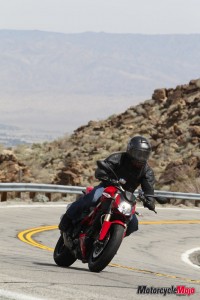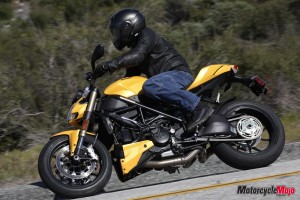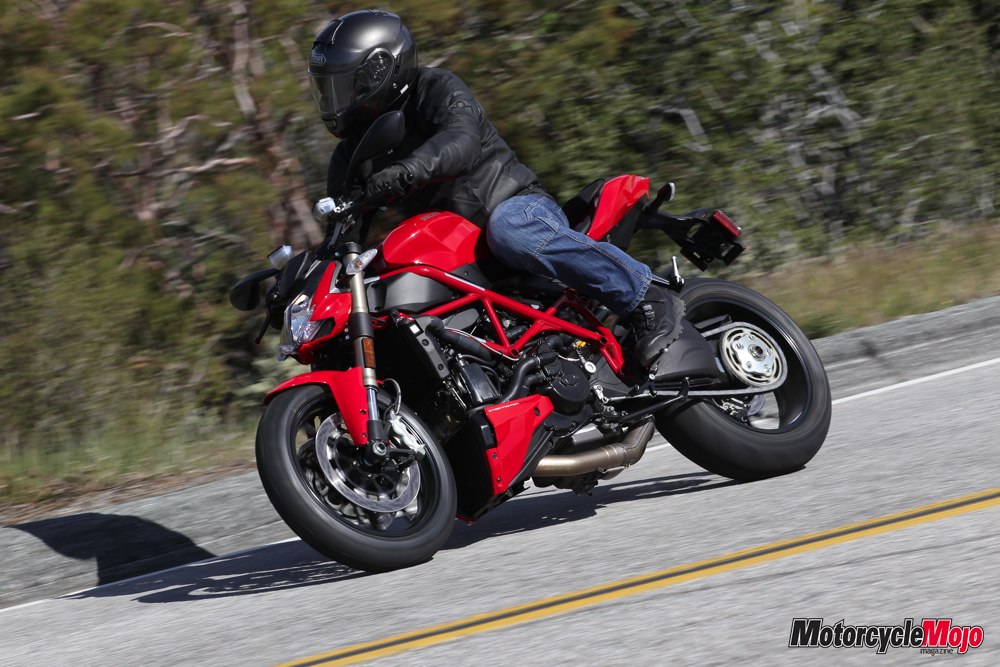I found it surprising that Ducati would launch their new street-fighting machine in the playground of Hollywood’s elite, Palm Springs, California, a city better suited to gambling and the gentleman’s sport of boxing.
I suspected that terrorizing the streets of this well-heeled desert city was not in the cards, but then again, where would we ride a bike better suited to carving canyons when we are surrounded by desert? Knowing California is rife with racetracks, I thought maybe they would let us loose on a road race course?
I should have known that Ducati North America would have an ace up their sleeve for the press launch of the new Streetfighter 848. We were promised a series of roads that would put the Streetfighter through its paces. With nary a straight section for most of the designated route, we would find ourselves on so many curves and elevation changes that we would wish it would stop. Well, not really.
 Ducati has been on a roll when it comes to releasing new models. In recent years they released the new 1200 Multistrada, then came the Diavel, and late last year, the completely new 1199 Panigale. Hot on the heels of the Panigale, Ducati announced the new Streetfighter 848. Like all modern Ducatis, the Streetfighter has a sleek form and a commanding presence, and with ten of them perfectly lined up under the trees of our Palm Springs hotel, I’m not the only one who thought so. Every time I walked by the row of bikes, there was always at least one hotel guest admiring them. Whether they rode or not, these Italian beauties have the ability to draw you in to dream.
Ducati has been on a roll when it comes to releasing new models. In recent years they released the new 1200 Multistrada, then came the Diavel, and late last year, the completely new 1199 Panigale. Hot on the heels of the Panigale, Ducati announced the new Streetfighter 848. Like all modern Ducatis, the Streetfighter has a sleek form and a commanding presence, and with ten of them perfectly lined up under the trees of our Palm Springs hotel, I’m not the only one who thought so. Every time I walked by the row of bikes, there was always at least one hotel guest admiring them. Whether they rode or not, these Italian beauties have the ability to draw you in to dream.
The 2012 Streetfighter is as naked as a bike can get – everything is exposed, revealing its exquisite fit and finish.
My first reaction when taking a seat and lifting the bike off of the side stand was surprise at its size. The bike feels small and light, with a reasonably comfortable seating position.
Seating position is canted forward – slightly more than a sport-touring bike, but not nearly as cramped as a sport bike. The engine is responsive and the brakes are powerful with excellent feel. All very favourable requisites for twisty mountain roads.
 Climbing from the desert floor to a constant rise with semi-tight bends and immaculate pavement allowed me to flex the Streetfighter’s muscle a bit. It was immediately apparent that the engine rpm needed to be kept above 4000, or upon twisting the throttle, the engine would shudder violently with very little acceleration. The vibration leveled out once the tach reached 4500, but above 5000 rpm is where the real fun begins and the exhaust barks with a deep throaty rumble on acceleration. Beginning at just 5500 rpm, the 849 cc, 4-valve per cylinder engine produces in the vicinity of 82 N-m (60.5 ft-lb) of torque and about 63 horsepower. The torque curve is fairly flat up to a claimed maximum of 93.5 N-m (69 ft-lb) at 9500 rpm while slightly higher, at 10,000, the 848 peaks out at a claimed 132 horsepower. Even into the upper reaches of the rpm range, the good-looking exposed L-twin engine didn’t seem over-revved.
Climbing from the desert floor to a constant rise with semi-tight bends and immaculate pavement allowed me to flex the Streetfighter’s muscle a bit. It was immediately apparent that the engine rpm needed to be kept above 4000, or upon twisting the throttle, the engine would shudder violently with very little acceleration. The vibration leveled out once the tach reached 4500, but above 5000 rpm is where the real fun begins and the exhaust barks with a deep throaty rumble on acceleration. Beginning at just 5500 rpm, the 849 cc, 4-valve per cylinder engine produces in the vicinity of 82 N-m (60.5 ft-lb) of torque and about 63 horsepower. The torque curve is fairly flat up to a claimed maximum of 93.5 N-m (69 ft-lb) at 9500 rpm while slightly higher, at 10,000, the 848 peaks out at a claimed 132 horsepower. Even into the upper reaches of the rpm range, the good-looking exposed L-twin engine didn’t seem over-revved.
The only difference between the Streetfighter 848 engine and the 848EVO superbike’s Testastretta engine is the degree of valve overlap. The Streetfighter uses an 11° overlap instead of the EVO’s 37°, resulting in a more manageable and less abrupt power delivery. The forgiving engine is user-friendly and the progressive power was much appreciated when carving hairpins on mountain roads, sometimes without guardrails.
The Streetfighter 848 was developed as an easier-to-use package for those who considered its big brother, the 1099 cc Streetfighter S, to be too much bike or too extreme as a canyon carver. Sometimes a smaller engine can be more fun in confined spaces, because you can use all of its power instead of just a small portion from a bigger powerplant.
Ducati owners have complained in the past of exorbitant maintenance costs, particularly the frequency and cost of valve adjustments. The engineers listened, and the new Desmodromic, liquid-cooled 848 engine now has a valve adjustment schedule of 24,000 kilometres, saving considerable time in the shop and money in your pockets.
The Streetfighter 848 has Ducati’s Traction Control as standard equipment. Controlled from the left-hand switchgear, the DTC, in addition to being turned off, has eight levels of sensitivity – level eight being the most neutered and level one being the least invasive for highly competent riders. The rider is first alerted to the DTC intrusion by lights on the instrument panel, and then if more intervention is need, the ECU retards ignition and initiates controlled fuel-injection cuts to limit rear wheel spin. The DTC is intelligent enough to analyze all inputs and act accordingly depending on lean angle, road speed, front and rear tire rotation, and throttle position, and it even knows not to intervene during a burnout or a wheelie.
I was surprised at the effort required to pull the hydraulic clutch lever. While the adjustable lever was stiff, it offered good feedback and a predictable mid-travel friction point. Requiring a light toe to shift either up or down, the six-speed gearbox was butter-smooth and positive, resulting in a light click to let you know you have completed the shift. Ducati’s quick shift system is available as an option allowing for open-throttle, clutchless shifting. Final drive is chain to the rear wheel mounted on a gorgeous, all-new, cast aluminum, single-sided swingarm.
While the driveline was flawless climbing the mountain roads and accelerating out of corners, the Brembo brakes were equally impressive at slowing the bike down before entering a corner too hot. Braking power was almost instant but manageable, with a light, two-finger squeeze to activate the 4-piston calipers on the pair of 320 mm semi-floating discs. A few times, I was grateful for the outstanding brakes when coming into a corner too fast or into a blind, decreasing radius. Unfortunately ABS is not available on either of the Streetfighter models.
Even though we were riding on near-immaculate pavement free of frost heaves and common imperfections that we regularly experience due to winter’s wrath, the suspension was stiff. The inverted 43 mm Marzocchi fork and the Sachs monoshock out back are fully adjustable and may have been set too firm, but on less than glass-smooth tarmac I could feel every ripple. Adjusting the suspension settings would result in a happy medium for our weather-beaten Canadian roads, and with 127 mm (5 in.) of travel front and back, it should be able to deliver a decent ride.
The suspension did a fine job of keeping the Pirelli Diablo Rosso Corsa tires hugging the road regardless of lean angle. Pirelli developed this tire technology for World Superbike competition, and the tires gave the utmost confidence as they stuck like glue while braking and accelerating hard out of corners. Tipping the scales at only 198 kg (437 lb.) soaking wet combined with a 24.5-degree rake, the Streetfighter tips into corners easily and is quickly flicked from side to side, but even with the wide handlebar it isn’t twitchy and readily maintains its composure in a straight line.
Keeping in mind that this bike is a street fighter, the riding position on the 848 is somewhat aggressive in that there is some weight on your wrists until you get to speed and then the windblast on your chest keeps much of the pressure off of the wrists. The seat to footpeg to hand grip ratio is comfortable enough and the thinly padded seat is adequate for most-of-the-day riding, but after almost 250 km, I was ready for a break. The bike does have a small pillion pad, but if I were you I wouldn’t suggest a cross-country trip to your better half. We didn’t have the opportunity to try the bike on the track, but I have no doubt it would be a very exciting track-day bike.
With a wheelbase of 1475 mm (58.1 in.), this bike is compact. You are leaning over the fuel tank, and while wearing a full-face helmet, the instrument panel is out of sight, as are the mirrors. You must make a conscious effort (by tilting your head down) to see your speed and anything behind you. The LCD instrument panel displays a bar-graph tach along the top, the lower right corner is the speedo, and the lower left displays the setting from the various menus. All this is controlled by the minimalist left-hand switchgear with buttons that work double duty. From the menu you can display lap times, DTC status, ambient air and coolant temperatures, battery voltage, two trip meters, and a trip that starts when the low-fuel light comes on.
The Streetfighter has a lot going for it, and you can’t go wrong if you are looking for a fun, easy-to-handle Italian beauty with a fiery personality and plenty of attitude. As pretty as it is, it comes with plenty of muscle on hand to take on all competitors. Whether it’s on the twistiest mountain roads or the nastiest back alleys of the city, the Streetfighter 848 has your back.


































